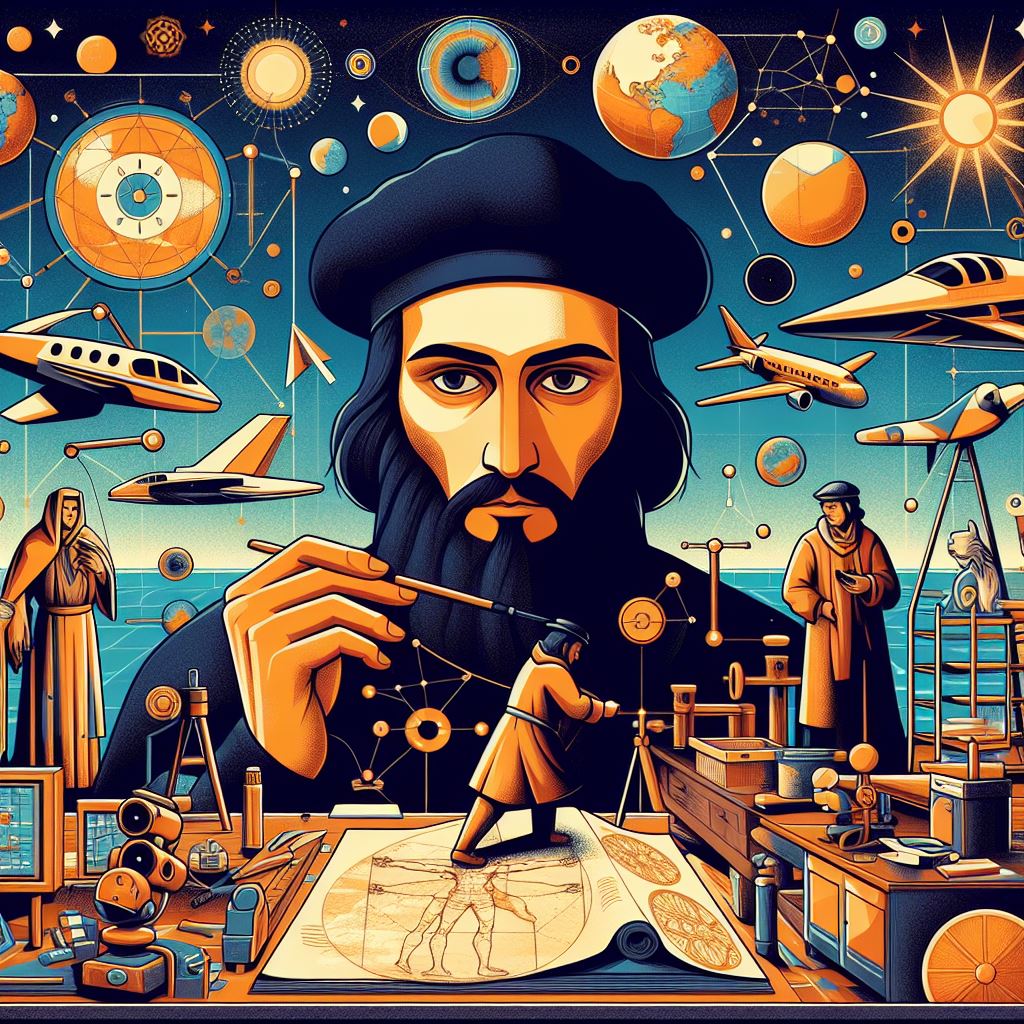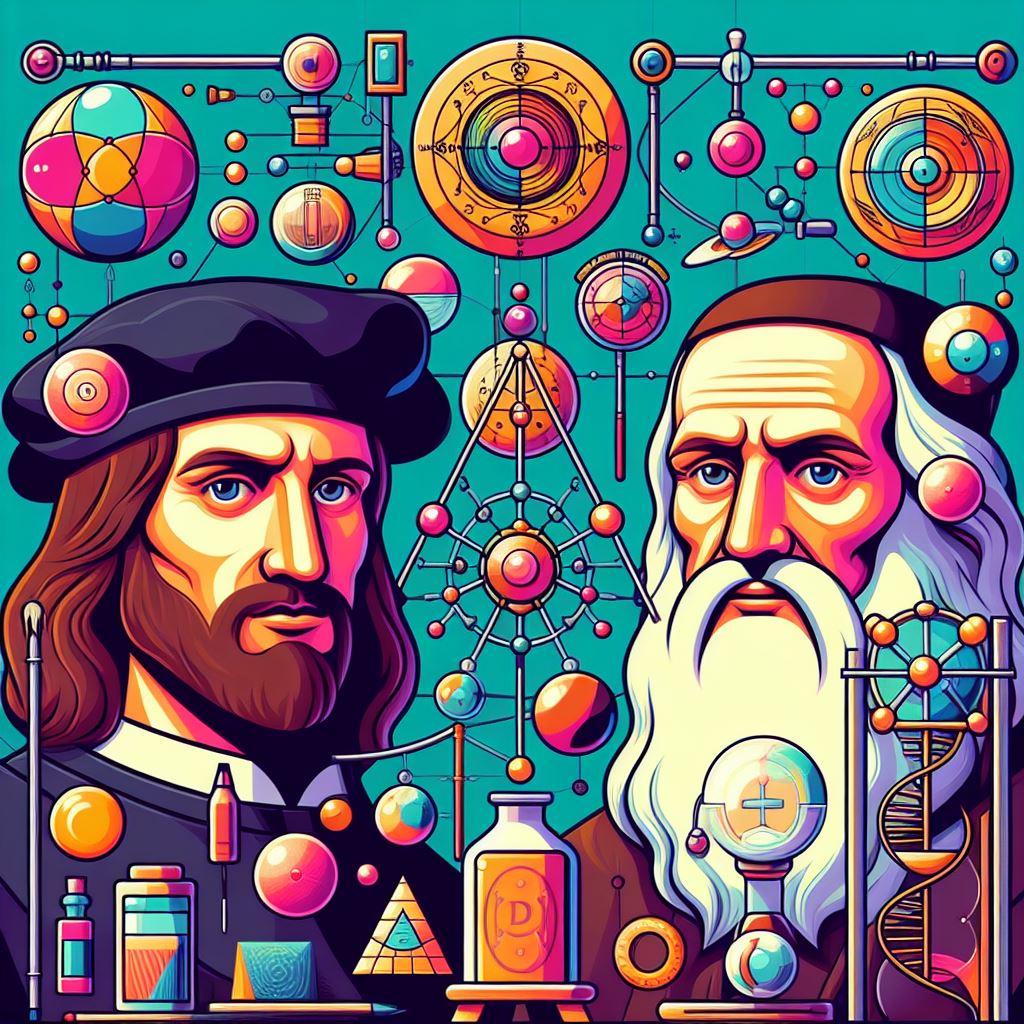Leonardo da Vinci endures as one of history’s most renowned and fascinating figures. Active during the Italian Renaissance as a painter, sculptor, architect, musician, mathematician, engineer, inventor, anatomist, geologist, cartographer, botanist and writer (Capra, 2007), da Vinci sought to study nature through science and represent beauty artistically.

This ScienceShot analyzes da Vinci’s contributions as a visionary inventor and engineer, assessing documented concepts and designs of technological systems often centuries ahead of working prototypes.
Following a biographical overview and discussion of his research methods, analysis focuses on innovations detailed in his voluminous notebooks in disciplines like civil engineering, aviation, warfare machinery, and robotics. Through an interdisciplinary lens integrating historical context and engineering analysis, da Vinci’s legacy as an inventor both representative and transcendent of his era is outlined. While many designs were impractical given technological constraints of his time, they demonstrate proto-types for later innovations across hydraulics, aeronautics, automata and optics.
Circulated posthumously, his work presaged multiple disciplines fundamental to modern engineering.
Biographical Context
Da Vinci was born in the hill town of Vinci, Republic of Florence (now Italy) in 1452, the illegitimate son of a prominent notary and a young peasant woman (Capra, 2007). He likely acquired early technical skills like metalworking and leathercraft via his father. Around the age of 15, he became apprentice in Florence’s Andrea del Verrocchio’s leading artistic workshop, absorbing concepts of perspective, anatomy and composition while collaborating on paintings and sculptures.
Demonstrating talent and versatility, da Vinci gained independent commissions and recognition by his early 20s while working at the Milanese court of Ludovico Sforza for nearly two decades (Kemp, 2011). As Milan declined, he returned to Florence undertaking scientific studies before accepting the role of chief architect and engineer to Cesare Borgia, enabling detailed surveying of central Italian terrain, fortresses and machinery. In later years, he worked in Rome and France, supported by successive patrons, before final retirement in France, where he died in 1519 at age 67.
Despite lack of formal university schooling, da Vinci’s insatiable curiosity and access to scholarly classes enabled self-education through experiential learning with little structured theoretical foundation. He embraced empirical methods two centuries before formalized, making painstaking observations recorded in mirror-script notebooks spanning mechanics, geometric studies, botany, anatomy, flight, optics and hydraulics alongside philosophical musings – attempting to discern order in nature’s complexity.
Practical inventions supplemented income between variable patronage. Many concepts centered on warfare machinery, civil and marine engineering projects matching interests of sponsors. Yet da Vinci’s creativity transcended immediate applicability. Upon his death, assistants inherited volumes of bound notebooks with over 7000 surviving pages of sketches and musings expressing an enormous breadth (Kemp, 2011).
Civil Engineering
Da Vinci envisioned ambitious infrastructure projects addressing contemporary 15th century problems of sieges and naval warfare as well as civilian transport and water supply aims, blending artistic imagination with nascent empirical understanding.
Military Engineering
While skilled fortification design helped da Vinci secure the role of Borgia’s chief engineer in 1502-03, earlier notes conceptualized novel defense systems (Galluzzi, 2019). Anticipating 19th century bastions, angled protrusions from fortification walls provided enfilade fields of defensive fire – an innovation allowing smaller garrisons to withstand sieges from larger attacking forces. Proposed waterway diversions and dams also aimed to submerge or bog down advancing troops.
Canal Systems and Aqueducts
To support Milan’s growth, da Vinci sketched plans for navigable canal links between major Italian cities for trade and transport, prefiguring 19th century networks built across Europe and America (Galluzzi, 2019). Lock gate mechanisms to raise and lower canal boats across elevation changes were refined from earlier Chinese versions. Da Vinci also suggested using triangular foundation support trusses andgradual inclined planes to construct ambitious aqueducts over valleys for gravity-fed fresh water supply to cities. While impractical given contemporary materials and construction methods, these showed engineering vision before discipline formalization.

Aviation and Aeronautics
Da Vinci carried out extensive studies into aviation and the mechanics of bird and bat flight as inspiration for winged human flight designs. While ballooning and gliding preceded powered flight, his schematics analyzed aerodynamic forces and control requirements presaging modern fixed-wing aircraft.
Ornithopters
Inspired by bird flight, da Vinci sketched and built model ornithopters attempting flapping-wing mechanisms to generate lift and thrust for potential human use, classifying bird species by wing shape (Laurenza, 2019). However efficiency limitations prevented success beyond short hops and even his towed and catapult-launched concepts faced control challenges. The fundamentals of aerodynamics - causal links between wing shape, wind resistance and balance enabling bird maneuvers were imperfectly understood by him and his contemporaries preceding 17th and 18th century physics formalizations. Nevertheless, modern efforts to build operational bio-inspired drones acknowledge da Vinci's pioneering nesting concepts.
Aerial Screw and Helicopter
Among da Vinci’s most famous aerial studies is the vertical takeoff and landing aerial screw, essentially a helicopter precursor (Laurenza, 2019). The concept features a platform harness for an aviator turning an overhead vane to generate upward thrust for hover and flight control. Unlike ornithopters, this build upon the rotating screw mechanism familiar from his era’s water pumps and Archimedean screws used for drainage and irrigation. Wind tunnel experiments helped quantify lift changes across differently pitched blades. Though impractical at the scale envisioned and lacking a power source, the aerial screw recognizes torque generation principals integral to helicopter driveshafts and tail rotors countering yaw developed centuries later. Related quadcopter sketches also seem strikingly prescient.
War Machinery
Beyond conventional cannon and fortifications, da Vinci envisioned novel offensive systems leveraging 15th century mechanical advancements across winches, gears, screws and the beginning shift from hand-production towards mechanization.
Gatling Gun
A crank-operated rapid-firing ‘organ gun’ concept comprised a battery of gun barrels firing sequentially as they rotated past fixed loading, firing and retrieval stations (Galluzzi, 2019). Gravity fed magazines and adjustable firing rates enabled sustained volleys. Inspired by organ pipes, this manual prototype for the aerial screw’s rotating power anticipates 19th century mechanical Gatling guns, where electric power and cartridges replaced gravity and fuse-lit cannons.
Armored Vehicles
Tank precursors in da Vinci’s notebooks feature protective covers, observation portholes, ring turrets and light cannons (Laurenza, 2019). Horse mobility and crankshaft steering aimed at camouflaged assault on enemy emplacements, suggesting an attacking vehicle combining speed, armor and firepower as tanks eventually enabled. Practical mobility issues aside, several characteristic staples emerge - vision from multiple angles, shields against projectiles, geometric solutions transferring circular motion to steering control and layered spherical protection balancing weight and ballistics still found in modern tank turret and chassis designs.
Robotics and Automata
While in line with the Renaissance’s mechanized marvels and clockwork curiosities, da Vinci’s automatic humanoid and creature designs also foreshadow disciplined robotics engineering integrating motion control, gears and logic for programmed response.
Bipedal Automaton
A famous robotic knight illustration demonstrates human into machine integration, unlike remote-operated puppets common at court pageants (Cianchi, 2019). The grasping hand, bendable elbows, movable jaw, neck and thighs showcase gear trains and pulley drives enabling smooth, natural movement. An envisioned camshaft programmer resembles modern punch card instructions stored via pins in the vertical drum, engaging corresponding cams driving appendage motions. Surpassing mere playthings, da Vinci sought to replicate integrated, anthropomorphic responses through mechanical computation.
Lion Automaton
Sketches for a walking, sitting and chest-opening lion automaton reveal similar nested design incorporating pulleys, levers, locks, springs and other elements triggering sequenced responses operated by an external crank (Cianchi, 2019). The early concept for modular subassemblies and logic gates guiding transitions between distinct operations offered an imaginative prototype. Coupled with locks disengaging certain gears, programmable memory in sequencing and branched choice is visible.
While fanciful reconstructions of floating fortresses, spring-powered carts and perpetual motion devices fill his notebooks too, core innovations discussed found conceptual or practical realization over time. Capra (2007) distills seven key characteristics emblematic across disciplines: systemic thinking, design mastery, curiosity and experimentalism, fusion of science, art and techne or craft knowledge, tolerance for uncertainty, creativity blending visions with practicality, and systematic integration weaving connections known as reticular thinking. Together, these traits enabled systematic observations explained through geometric mechanisms and physical causes within creative design syntheses far beyond a lone inventive genius stereotype. Da Vinci critiqued earlier sources, selectively fused ideas across domains and judged feasibility amid constraints - identical processes underpinning innovation ecosystems today, though vastly accelerated. In laying these mental frameworks navigating the tangible and theoretical, his legacy persists indirectly through the scientific culture underpinning present engineering advancement.
Conclusion
Polymathic individuals piercing disciplinary walls remain rare but valued in the innovation ecosystem, enabling contextual peripheral vision unveiling unexplored possibilities at established frontiers. While later developments built directly on da Vinci’s engineering sketches seem limited, his approach resonates with mythic archetypes of the Renaissance master. Practical inventions addressed sponsors’ interests yet transcended immediate usefulness, as true engineering does in reframing perspectives. If genius represents seeing familiar reality through new lenses, da Vinci prototyped engineering itself amid the 15th century’s intermingling currents of artisanal traditions and emergent dynamics thinking that forged our world today. In this sense, his vast creativity manifested the adjacent possible, rendering ideas eventually viable through science’s progressive enterprise through his profound intuition and imagination.
References
- Capra, F. (2007). Science and da Vinci. Dotlet: Diaries of Talents and Their Likes.
- Cianchi, L. (2019). Leonardo’s Machines: Da Vinci’s Inventions Reconstructed. Giunti.
- Galluzzi, P. (2019). Leonardo da Vinci: Engineer and Architect. Montreal Museum of Fine Arts.
- Kemp, M. (2011). Christ to Coke: How Image Becomes Icon. Oxford University Press.
- Laurenza, D. (2019). Leonardo’s Flying Machines. Giunti.